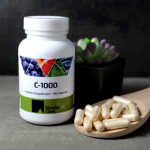High-dose Intravenous Vitamin C as a Successful Treatment of Viral Infections
 Author: Nina Mikirova, PhD
Author: Nina Mikirova, PhD
Originally published: February 2014
Do you know that injections of vitamin C were successfully used in treating polio, diphtheria, herpes zoster (shingles), herpes simplex, chicken pox, influenza, measles, mumps, and viral pneumonia in the middle of the 20th century? Most of these treatments are described in the book “Injectable Vitamin C: Effective Treatment for Viral and Other Diseases.” This book is a tribute to and acknowledgment of the important thinking and work of Dr. Fred R. Klenner and other physicians and researchers who worked in medicine from the 1930s to the 1970s. They made the pioneering efforts on the medical use of injectable vitamin C in the treatment of viral infection. One of the first studies in the inactivation of poliomyelitis virus in an in vitro setting using crystalline vitamin C (ascorbic acid) was designed by C. W. Jungeblut, MD in 1935.
In 1949, Dr. Klenner reported successful treatment of polio, diphtheria, herpes zoster, herpes simplex, chicken pox, influenza, measles, mumps, and viral pneumonia with injections of large doses of vitamin C. “The results,” he wrote, “which we have reported in virus diseases using vitamin C as the antibiotic may seem fantastic.”
In the poliomyelitis epidemic in North Carolina in 1948, 60 cases of this disease came under his care. The treatment employed was vitamin C in massive doses. It was given like any other antibiotic every two to four hours. The initial dose was 1000 to 2000 mg, depending on age. This schedule was followed for 24 hours. After this time the fever was consistently down, so the vitamin C was given 1000 to 2000 mg every six hours for the next 48 hours. All patients were clinically well after 72 hours.
In the treatment of other types of virus infections, the same dose schedule was adopted. In herpes zoster, 2000 to 3000 mg of vitamin C was given every 12 hours; this was supplemented by 1000 mg in fruit juice by mouth every two hours. Eight cases were treated in this series, all adults. Seven experienced cessation of pain within two hours of the first injection and remained so without the use of any other analgesic medication. Seven of these cases showed drying of the vesicles within 24 hours and were clear of lesions within 72 hours. They received from five to seven injections. Chicken pox gave an equally good response, the vesicles responding in the same manner as did those of herpes.
 In addition, Dr. Klenner treated many cases of influenza with vitamin C. The size of the dose and the number of injections required were in direct proportion to the fever curve and to the duration of the illness. Further the response of encephalitis virus to ascorbic acid therapy was dramatic. Six cases of encephalitis were treated and cured with vitamin C injections. Two cases were associated with the pneumonia virus; one followed chicken pox, one mumps, one measles and one a combination of measles and mumps. In all these cases definite evidence was found to confirm the belief that massive, frequent injections are necessary in treating virus infections with vitamin C.
In addition, Dr. Klenner treated many cases of influenza with vitamin C. The size of the dose and the number of injections required were in direct proportion to the fever curve and to the duration of the illness. Further the response of encephalitis virus to ascorbic acid therapy was dramatic. Six cases of encephalitis were treated and cured with vitamin C injections. Two cases were associated with the pneumonia virus; one followed chicken pox, one mumps, one measles and one a combination of measles and mumps. In all these cases definite evidence was found to confirm the belief that massive, frequent injections are necessary in treating virus infections with vitamin C.
Dr. Klenner published all studies of a variety of diseases successfully treated through massive injections of vitamin C and suggested that that due to effectiveness of injectable vitamin C, this vitamin can be considered as a super antibiotic.
Another pioneer in the therapeutic use of injectable vitamin C, Dr. W.J. McCormick, notes that while until 1952 vitamin C had been used “primarily and solely” to counteract deficiencies of the vitamin, it also has potent chemotherapeutic properties when given in large repeated doses, preferably intravenously or intramuscularly.
In 1954 the article, “Treatment of hepatitis with infusions of ascorbic acid: comparison with other therapies,” by H. Baur and H. Staub was published in a Swiss (German) medical journal. The article reported that injectable vitamin C was used successfully to treat 11 hepatitis patients at the University of Basel Medical Clinic between 1951 and 1952. Results compared favorably with those obtained in 195 patients who were treated by other means. The vitamin C injections were 10 grams per day.
Later in 1962, Dr. W.L. Dalton described treating a severe case of acute hepatitis in his article, “Massive doses of vitamin C in the treatment of viral diseases.” This study reports on the successful use of a preparation for intravenous administration consisting of 2000 mg of ascorbic acid per dose fortified with certain B-vitamins to treat several different viral-caused diseases including hepatitis, mononucleosis, and pneumonia.
Despite all these studies, there was resistance by the medical profession to the use of large amounts of vitamin C in treating viral disease. As Linus Pauling complained, “the medical community requires rigorous evidence supporting vitamin C but accepts flimsy evidence against it.”
According to recent knowledge, people with viral infections have low serum levels of vitamin C, which may be due to increased utilization of vitamin C for the detoxification of reactive oxygen species (ROS) during inflammation caused by infection. Viral infections produce severe oxidative stress, contributing to cellular damage and disease progression. Low serum vitamin C in these individuals may be due to the increase in inflammatory and oxidative processes that take place during a pathological state.
When subjects are exposed to a viral infection, the need for vitamin C is increased, depending on the body’s immune function. It was therefore proposed that in the clinical  management of viral infections, especially in the early stages, considerable benefits will be noticed from antioxidant repletion with dosages substantially above recommended daily allowances.
management of viral infections, especially in the early stages, considerable benefits will be noticed from antioxidant repletion with dosages substantially above recommended daily allowances.
In recent years, vitamin C has been under investigation for its role as an antiviral agent, either by itself or as an adjunctive therapy to be administered in company with a conventional treatment. It was shown that vitamin C at sufficiently high doses can prevent viral disease and greatly speed recovery from an acute viral infection.
Most studies use an in-vitro (outside of a living organism) setting. In vivo studies (those using a live organism) are scarce because the use of animals that have the ability to synthesize ascorbic acid is problematic.
Several mechanisms for vitamin C’s antiviral effect are known or suggested from these studies. First, the antioxidant property of vitamin C promotes a reducing environment in the bloodstream and tissues, enhancing the body’s response to oxidative stress from inflammation, thereby helping to fight microbes and viruses that propagate in stressful conditions.
 Viral infections often lead to oxidative stress to the infected cells, and therefore, antioxidants are expected to suppress oxidative stress and work as antivirals or ‘drugs,’ improving inflammatory symptoms. Among these substances, the protective effect of ascorbic acid has been assumed due to its powerful scavenging and antioxidative property.
Viral infections often lead to oxidative stress to the infected cells, and therefore, antioxidants are expected to suppress oxidative stress and work as antivirals or ‘drugs,’ improving inflammatory symptoms. Among these substances, the protective effect of ascorbic acid has been assumed due to its powerful scavenging and antioxidative property.
Vitamin C is also involved in enhancing several functions of the immune system. Cells of the immune system have one of the highest concentrations of vitamin C: white blood cells have an 80 times concentration of vitamin C in their cytoplasm, allowing them to create a vitamin C concentration surplus at the site of infection. Vitamin C can also enhance the production of interferon, which helps prevent cells from being infected by a virus, stimulate the activity of antibodies and cytokines, and in mega-doses, play a role in mitochondrial energy production. It can enhance the ability of specialized immune cells to ingest bacteria.
In addition to this general neutralizing effect, vitamin C interferes with the assembly of viral RNA and DNA. In a recent study (2012), in vitro experiments showed ascorbate’s ability to kill isolated influenza viruses, as well as viruses from normal human bronchial epithelial cells. There was a dosedependent effect—a concentration of 2.5mM was able to eliminate 90% of the virus present and a 20 mM solution completely stopped the replication of the virus. The antiviral effect of ascorbate is greater when introduced in the early stages of infection.
It was also proved that the antiviral activity of ascorbic acid is not virus-specific. The researchers used 3 different types of viruses and measured relative virus yields and fraction of dead cells after the addition of solutions of ascorbic acid or dehydroascorbic acid. The virus yield decreased as the reagent concentration was increased, and in the presence of 30 mM of the reagent, the yields of these viruses were approximately one tenth of those  in the absence of the vitamin C. These results show that ascorbic acid inhibits the multiplication of viruses of widely different structures, i.e., regardless of enveloped or non-enveloped, double-stranded DNA or singlestranded RNA genome, and regardless whether the replication and transcription of the viral genome occur in the nucleus or in the cytoplasm of the infected cells. For characterization of the mode of action of ascorbic acid, authors suggest that either free radical formation or direct binding to virus, or both, is responsible for the antiviral activity of vitamin C.
in the absence of the vitamin C. These results show that ascorbic acid inhibits the multiplication of viruses of widely different structures, i.e., regardless of enveloped or non-enveloped, double-stranded DNA or singlestranded RNA genome, and regardless whether the replication and transcription of the viral genome occur in the nucleus or in the cytoplasm of the infected cells. For characterization of the mode of action of ascorbic acid, authors suggest that either free radical formation or direct binding to virus, or both, is responsible for the antiviral activity of vitamin C.
Among in vivo studies, we can mention a multicenter prospective cohort study of 16 general practitioners from Germany, involving 67 symptomatic herpes-zoster (shingles) patients that received intravenous vitamin C treatment, with dosage of 7.5g/50ml for 2 weeks, in addition to standard treatment for shingles. The data provide evidence that concomitant use of intravenously administered vitamin C along with the shingles treatment may have beneficial effects on herpes zoster-associated pain, dermatologic findings and accompanying common complaints.

In our Clinic, we analyzed the effect of intravenous vitamin C therapy on patients with Epstein-Barr virus (EBV). EBV is a member of the herpes family that targets lymphocytes and epithelial cells. While the infection is usually benign, it can in some cases lead to acute infectious mononucleosis and can impair the immune system. EBV is linked to several malignancies, including Burkett’s lymphoma, post-transplant lymph-proliferative disease, Hodgkin’s disease, and several autoimmune diseases.
There has been very little success treating acute EBV infection and mononucleosis with drugs. Corticosteroids may be helpful in treating complications of infectious mononucleosis, including central nervous system involvement, myocarditis, tonsillar enlargement causing airway obstruction, and hemolytic anemia. However, a double-blind study showed that acyclovir had no significant effect on symptoms of EBV-related infectious mononucleosis.
 Our data provide evidence that high dose (7.5 to 50 grams) intravenous vitamin C (IVC) therapy may have a positive effect on disease duration and may reduce viral antibody levels. The benefit seems to be dependent upon the number of IVC treatments given, as patients given ten or more IVCs had significantly greater reduction in viral antibody load when compared to untreated controls.
Our data provide evidence that high dose (7.5 to 50 grams) intravenous vitamin C (IVC) therapy may have a positive effect on disease duration and may reduce viral antibody levels. The benefit seems to be dependent upon the number of IVC treatments given, as patients given ten or more IVCs had significantly greater reduction in viral antibody load when compared to untreated controls.
Further research and clinical studies are warranted in finding the effect of ascorbic acid on the boosting of the immune system, stimulation of anti viral activity of leukocytes (white blood cells) and proving the mechanisms underlying the action of vitamin C in viral disease. Read more about the research conducted at Riordan Clinic.




